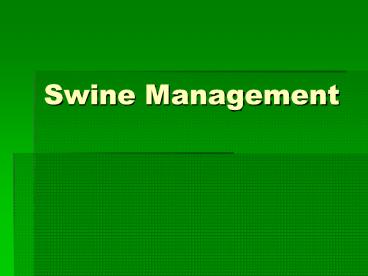Swine Management - PowerPoint PPT Presentation
1 / 36
Title:
Swine Management
Description:
Swine Management Characteristics of swine Pigs are Homeotherms Maintain a constant body temperature Pigs are Monogastrics Pigs have very few sweat glands Housing ... – PowerPoint PPT presentation
Number of Views:835
Avg rating:3.0/5.0
Title: Swine Management
1
Swine Management
2
Characteristics of swine
- Pigs are Homeotherms
- Maintain a constant body temperature
- Pigs are Monogastrics
- Pigs have very few sweat glands
3
Housing
- Types of houses
- Outside pen
- A- frame houses
- Open front buildings
- Environmentally regulated buildings
4
Housing
5
Housing
6
Reproduction
- Natural
- AI
- Heat period averages 2 days and occurs every
20-21 days - Can synchronize gilts by putting them together
and in a pen next to a boar - Lock up when in heat (Lordosis)
7
Reproduction
8
Reproduction
- Boar penis is corkscrewed
- AI rod has to be corkscrewed as well
- Boar semen cannot be frozen
- Shipped fresh overnight
- 2 doses of semen are administered
- 24 hours after 1st incidence of standing heat
- 12 hours later
- Done because pigs are superovulaters
9
Farrowing
- Farrowing the act of parturition
- Gestation period- 114 days (3X3X3)
- Put into farrowing crates few days before
expected parturition - Sows can have any number of babies
- Wean at 21 days
- Pigs are very susceptible to disease
- Many farms are total confinment
10
Farrowing Crates
- Used to protect the baby pigs from being crushed
by the sow - Sow is confined in the middle so that she cant
turn around - Equipped with feeder and watering device
- Space on both sides of the sow for babies
- Use a heat lamp to keep babies warm
11
Farrowing Crates
12
Navel Cord Care
- After birth excess navel cord is removed
- Leave about 1 inch
- Treat navel cord with iodine
- Why?
- Prevent infection
13
Navel Cord Care
14
Clipping needle teeth
- Born with only eight teeth
- Fairly long and sharp
- Can irritate the sow while nursing
- Can remove these teeth to make more comfortable
for the sow - We dont clip
15
Clipping needle teeth
16
Tail Docking
- Pigs are normally in a confined space
- Chew on others tail
- Done out of boredom
- To prevent tail biting and the possibility of
infection, tails are docked - Dock were tail can barely touch the pigs back
17
Tail Docking
18
Injections
- 3 types of injections
- Subcutaneous
- Intramuscular
- Intravenous
- Two sites to give an injection
- Neck
- Ham
19
Injections
20
Injections
21
Injections
22
Injections
- Iron is administered about 24 hours after birth
- 1 cc of iron
- Since pigs are in a create and dont have access
to soil, iron- deficiency anemia can occur - Some people give a small dose of antibiotic
- Give the sow penicillin
23
Ear Notching
- Most used identification method for baby pigs
- Removing a portion of the ear
- The notches grow as the pig grows
- Permanent identification
- Litter and Pig
- Litter - the pigs right ear
- Pig - the pigs left eat
24
Ear Notching
- Litter
- Number of litter for the whole farm
- Not for individual sow
- Pig
- Individual number for the baby pig
- Has nothing to do with the rest of the farm
25
Ear Notching
26
Ear Notching
27
Ear Notching
28
Castration
- Removal of the testicles
- Pigs are castrated if meant for slaughter
- Meat from boars may have an odor when cooking
- Takes testosterone out of the system, which makes
meat tough
29
Castration
- Best time for castration is between 1 and 14 days
- Pigs are easier to restrain
- Bleed less from the surgery
- One person holds the pig by the back legs and the
other person does the castrating - Make small incisions
- Make sure to use some type of antiseptic spray
30
Castration
31
Castration
32
Castration
33
Castration
34
Parasites
- Coccidia
- Affects nursing pigs between days 5 and 15
- Develop a yellowish, very fluid diarrhea
- Infected pigs do not respond well to antibiotic
treatment - Mortality rates will be moderate to high
35
Parasites
- Worms
- Roundworms
- Nodular worms
- Whipworms
- Threadworms
- Stomach worms
- Lungworms
- Kidney worms
- Doesnt occur much in baby pigs
36
Weaning
- Baby pigs are weaned at 21 days
- Put in a nursery for a few weeks
- Until pigs are 40 45 lbs
- Moved to other pens for growing and finishing































